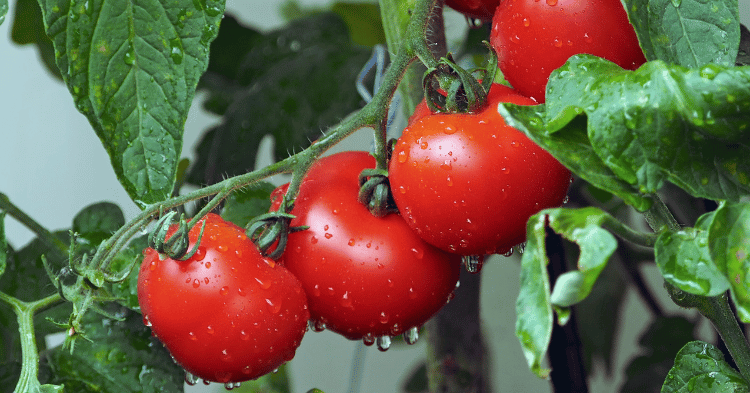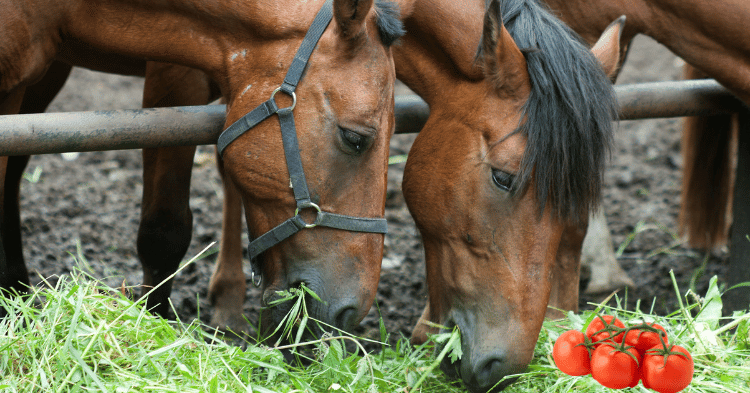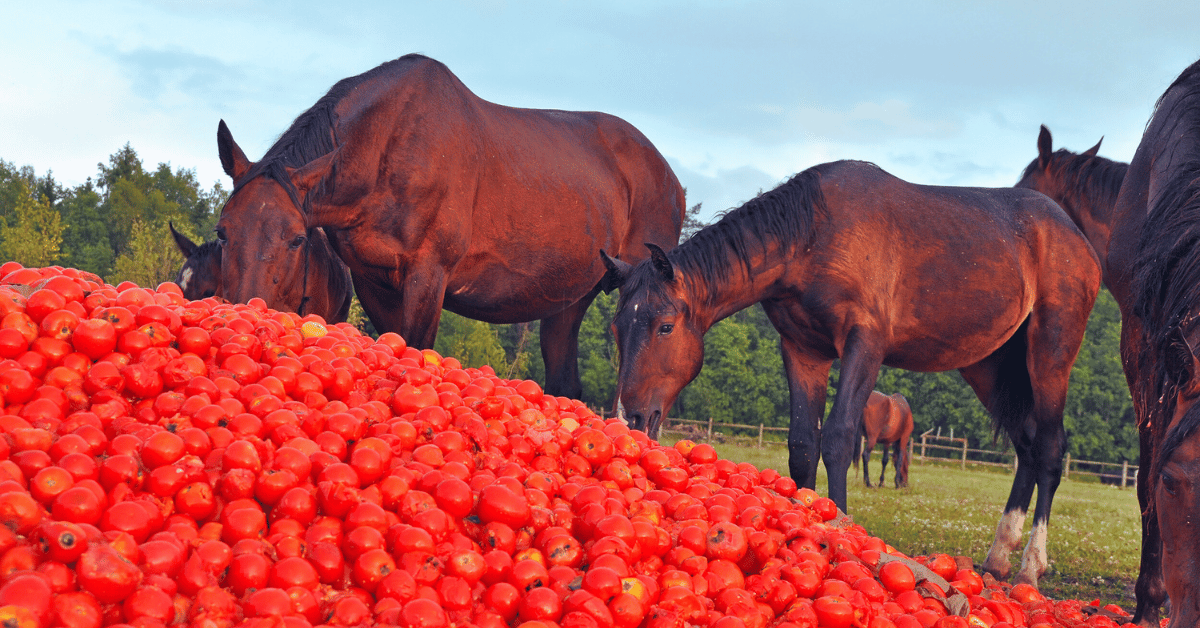When it comes to sharing snacks with your horse, not everything from your kitchen is safe. So, can horses eat tomatoes? The answer is a clear no. While tomatoes might seem harmless, they belong to the nightshade family, containing a toxic compound called solanine. Even small amounts can cause severe digestive upset, colic, or worse, if ingested by horses.
Despite their vibrant appeal, tomatoes and their plants—stems, leaves, and fruit—pose a serious risk to your equine friend. Symptoms of tomato poisoning can range from lethargy and diarrhea to more severe reactions like difficulty breathing or seizures.
As a responsible horse owner, it’s crucial to keep tomatoes and other nightshade plants well out of reach. Instead, opt for horse-friendly treats like carrots, apples, or watermelon. Understanding these guidelines ensures your horse stays healthy and safe while enjoying a balanced diet.
Understanding Horse Diets
To ensure a healthy and happy horse, it’s crucial to understand the essential components of their diet and maintain a proper feeding schedule. Below are guidelines that will help in understanding and managing a horse’s dietary needs.
Essential Components of a Horse’s Diet
Horses are herbivores and require a specific diet rich in fiber to maintain their long, sensitive digestive systems. Their diet mainly consists of the following:
- Grass: Fresh pasture grass is a staple in a horse’s diet, providing necessary fiber and nutrients.
- Hay or Haylage: Essential especially when fresh grass is not available; hay/haylage should form at least half of a horse’s diet.
- Concentrates: Grains and other concentrated feeds may be added for extra energy, particularly for working horses.
- Salt: Salt blocks or loose salt should be made available to replenish essential minerals.
- Fruits and Vegetables: A small amount of fruits and vegetables can be included. Wondering can horses eat tomatoes grows in relevance here.
| Diet Component | Description |
|---|---|
| Grass | Provides fiber, essential nutrients |
| Hay/Haylage | Vital when fresh grass is not available |
| Concentrates | Extra energy for working horses |
| Salt | Replenishes essential minerals |
| Fruits/Vegetables | Occasional treats, ensure they are safe |
Reference: SPANA
Proper Feeding Schedule for Horses
Feeding schedules are vital in maintaining a horse’s health. Horses should be fed little and often, reflecting their natural grazing habits:
- Frequency: Horses should be fed two to three times per day if kept in a stable.
- Total Daily Intake: An average adult horse consumes dry matter weighing around 1.5–3% of its body weight. This depends on activity level and food quality.
- Feeding Durations: Avoid leaving the horse without food for longer than eight hours. Horses thrive on routine, which helps stabilize their digestive system.
- Daily Amount: A balance should be maintained between forage (at least 50% of the diet) and concentrates, along with adequate water supply.
| Feeding Frequency | Description |
|---|---|
| Two to three times/day | Ideal for stabled horses |
| Little and often throughout the day | Mimics natural grazing |
| No more than 8 hours without food | Prevents digestive issues |
| Consistency in feeding times | Supports a stable routine |
Reference: SPANA
In conclusion, a balanced and consistent diet, tailored feeding schedule, and careful inclusion of supplements like fruits and vegetables ensure the optimal health of your equine companion. For detailed guidelines on specific foods, you might be curious to explore can horses eat bananas, can horses eat grapes, and can horses eat celery.
Can Horses Consume Tomatoes?

Understanding whether horses can eat tomatoes is crucial for any responsible horse owner. This section explores the safety concerns and potential risks associated with feeding tomatoes to horses.
Safety of Feeding Tomatoes to Horses
Ripe, red tomatoes can be safely consumed by horses in small quantities (JustAnswer). It is important to ensure that only the ripe fruit is fed to horses, avoiding any green parts of the tomato plant such as leaves and stems. These green parts contain higher concentrations of toxic compounds that can pose a risk to horses.
Relevant safety guidelines include:
- Limit tomatoes to 10% of the horse’s daily diet.
- Cut tomatoes into small, bite-sized pieces.
- Remove stems and leaves before feeding.
- Wash thoroughly to remove dirt or chemicals (Bailey’s CBD).
Risks Associated with Tomatoes in a Horse’s Diet
While tomatoes can provide health benefits such as reducing inflammation and supporting overall health, there are notable risks associated with their consumption. This is primarily due to the presence of compounds like solanine and tomatine, which are toxic to horses when consumed in large amounts (Dream Horse).
Potential risks include:
- Toxicity from solanine and tomatine, particularly in green parts of the tomato plant.
- Gastrointestinal upset if consumed in excessive quantities.
- Symptoms of toxicity include colic, diarrhea, and lethargy.
| Tomato Part | Solanine & Tomatine Content | Safe for Horses? |
|---|---|---|
| Ripe, Red Fruit | Low | Yes, in moderation |
| Leaves | High | No |
| Stems | High | No |
| Unripe Fruit | Moderate-High | No |
Monitoring horses for adverse reactions is essential when introducing any new food into their diet. Consulting a veterinarian is always recommended to ensure that the diet remains balanced and safe for the horse.
For more guidelines on feeding horses various fruits and vegetables, check out our articles on can horses eat bananas, can horses eat watermelon, and can horses eat grapes.
Remember, while tomatoes can be a tasty treat, moderation and proper preparation are key to keeping your horse healthy and happy.
Benefits of Tomatoes for Horses

Tomatoes offer a variety of nutritional and health benefits that can potentially benefit your horse’s diet. Understanding these can help you make an informed decision about including tomatoes in their feed.
Nutritional Value of Tomatoes for Horses
Tomatoes are rich in essential vitamins, minerals, and antioxidants that are beneficial for horses. Here is a breakdown of the key nutrients found in tomatoes and their roles:
| Nutrient | Benefits |
|---|---|
| Vitamin A | Maintains healthy skin, immune function, and vision (Bailey’s CBD) |
| Vitamin C | Acts as an antioxidant, helps to protect cells from damage (Dream Horse) |
| Vitamin K | Plays a role in blood clotting and bone health (Dream Horse) |
| Potassium | Regulates fluid balance and nerve function (Bailey’s CBD) |
| Lycopene | An antioxidant that improves cardiovascular health and reduces inflammation (Dream Horse) |
Potential Health Benefits of Feeding Tomatoes
Feeding tomatoes to horses, in moderation, can offer several potential health benefits:
- Reduced Inflammation: Lycopene, an antioxidant found in tomatoes, has been linked to reduced inflammation. This can be particularly beneficial for horses suffering from conditions like arthritis or joint inflammation.
- Improved Cardiovascular Health: Antioxidants like lycopene also support cardiovascular health by protecting blood vessels (Dream Horse).
- Enhanced Immune Function: The high vitamin C content in tomatoes helps to bolster the immune system, keeping your horse healthy and more resilient against illnesses.
- Better Skin and Vision: Vitamin A is crucial for maintaining healthy skin and vision. Supplementing your horse’s diet with tomatoes can help support these vital functions (Bailey’s CBD).
Always monitor your horse when introducing new foods to their diet and consult with a veterinarian to ensure their safety. For more information on what your horse can or cannot eat, check our articles on can horses eat bananas and can horses eat watermelon.
Proper Handling of Tomatoes for Horses
Feeding tomatoes to horses requires careful preparation and monitoring to ensure their safety. Here are some guidelines and best practices.
Preparation and Feeding Guidelines
Not all tomatoes are safe for horses. It’s crucial to select ripe, red tomatoes and avoid green or unripe ones, which contain toxic compounds like solanine and tomatine. These substances can cause digestive troubles, muscle weakness, and other health issues (Bay Area Equestrian Network).
To prepare tomatoes for horses:
- Wash thoroughly: Remove any dirt or chemicals from the surface.
- Remove stems and leaves: These parts can be particularly harmful.
- Cut into small pieces: This makes it easier for the horse to eat and digest.
| Tomato Part | Safety for Horses |
|---|---|
| Ripe, Red Flesh | Safe |
| Green, Unripe Flesh | Unsafe |
| Stems and Leaves | Unsafe |
An appropriate serving size is crucial. These small, bite-sized pieces should be incorporated sparingly into the horse’s diet. Overfeeding can lead to health complications regardless of the tomato’s ripeness.
Monitoring and Consulting Veterinarians
Introducing any new food, including tomatoes, into a horse’s diet should be done cautiously. Here are some steps to follow:
- Start small: Begin with a minimal amount to observe any immediate reactions.
- Monitor the horse: Watch for signs of distress, such as colic, diarrhea, or changes in behavior.
- Consult a veterinarian: Regular check-ups are important. Consult a vet if unsure about feeding tomatoes or if any reaction occurs.
Should the horse show any adverse symptoms after eating tomatoes, it’s imperative to contact a veterinarian immediately. They can provide tailored guidance based on your horse’s health and diet. For more about horse dietary concerns, visit our horse diet guide.
Internal links:
- Explore whether horses can consume other fruits like bananas and watermelon.
- Learn about other aspects of horse care, such as whether horses can sleep standing up.
- Read about potential health risks with foods like pumpkin and pears.
Properly handling and monitoring the introduction of tomatoes can help ensure your horse’s diet remains safe and healthy.

